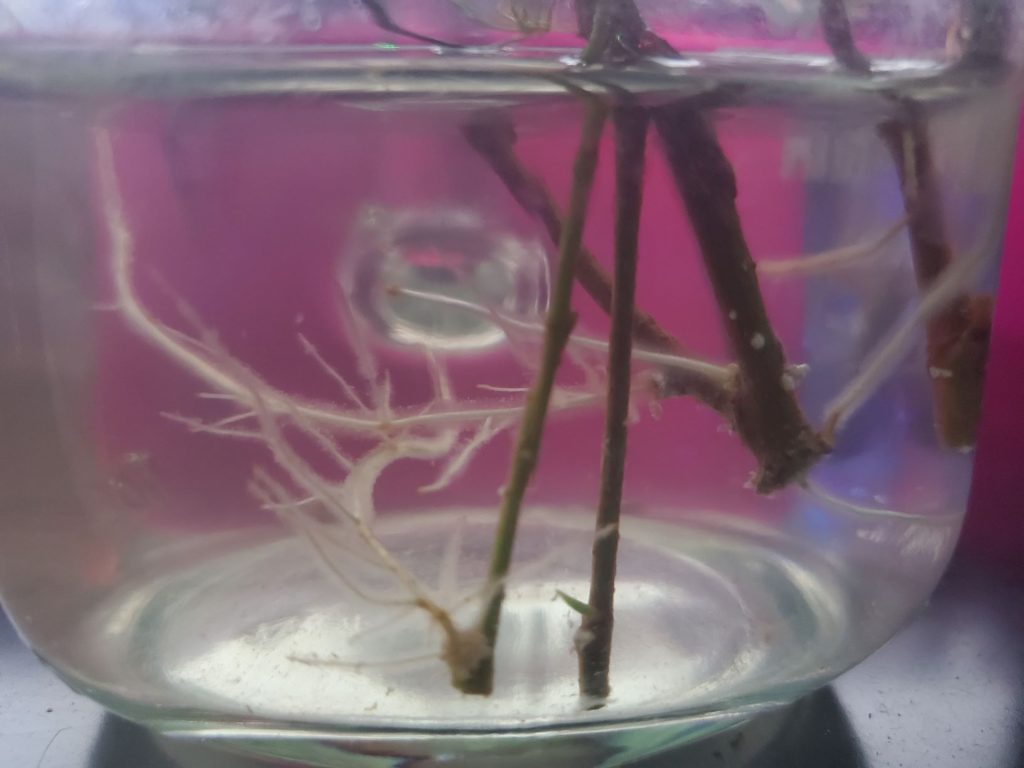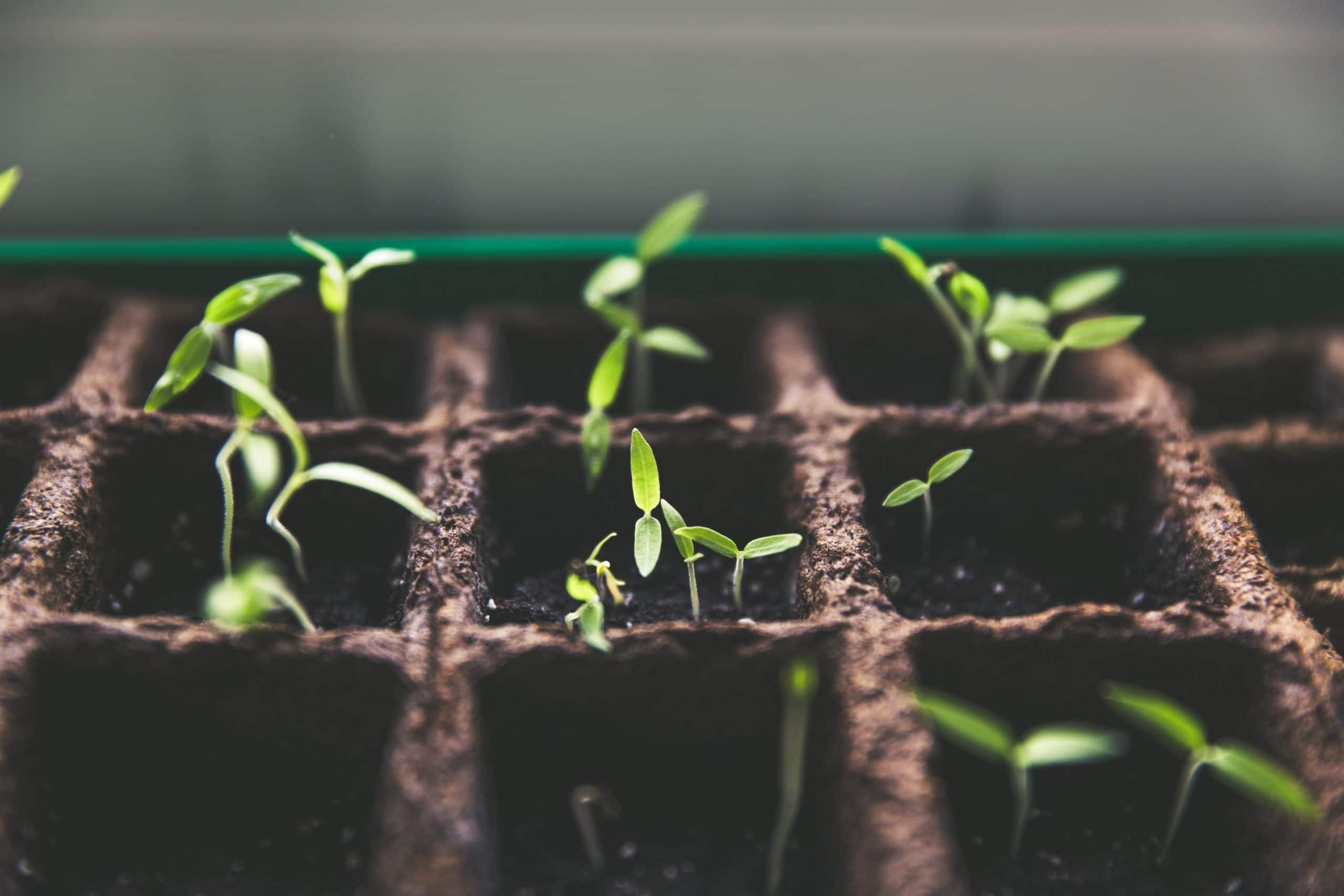Here’s How to Tell if Your Cuttings Have Rooted in Water
The stem will have (half inch or 1-2 cm) hair-like roots forming. Your cutting has begun rooting and is safe to place into potting soil. Lift the cutting out of the water and check the bottom of the stem to see if it has developed any root tendrils.

How to Tell if Your Cuttings Have Rooted in Soil:
Carefully remove some of the soil around the base of the stem to see if there are any roots reaching into the soil below. Be careful not to tug on the plant as this may tear the newly formed roots and will likely slow the growth of your new plant or kill it entirely. (Trust me, I’ve lost many plants this way)
How to Make Cuttings Root Faster:

- Take new growth cuttings that have at least 3 or 4 nodes above the cut, these are more likely to survive.
- Carefully remove some of lower leaves from the cutting, be sure to keep a few near the top.
- Propagate in water first by filling a small cup with one inch of fresh water and place the cutting into it.
- Use rooting hormone (available online or at nurseries) to help stimulate root growth.
When to Transfer Rooted Cuttings to Soil:
2-4 weeks
Once your cuttings begin to form tiny hair-like roots in the water (usually 2-4 weeks) that are a half-inch long it is safe to plant them directly into some potting soil. The longer you wait, the more roots that will form on the stems and new leaves will begin to form as well. This will increase the likelihood that your plants will succeed in soil. Some cuttings will not survive the transfer to soil, this is normal. Generally, only 50% of cuttings will be successful.
How to Transplant Rooted Plants into Soil:
Now that you have successfully started to grow some roots off your cuttings it’s time to plant these babies into some soil and watch them grow into beautiful adult plants.
- Fill your pots half-way with fresh potting soil. Use your finger to poke a small divot in the center.
- Remove your cuttings from their water and rinse them in the sink. Remove any slime or algae from the stems being careful not to damage the delicate newly formed roots.
- Insert your cutting into the pot directly in the center where you made the hole.
- Add some additional soil to the pot and press the soil down firmly with your fingers around the edges first, then around the base of the stem so the cutting is able to stand up on its own.
- Give the soil a good soak with cool water. Make sure the water is able to drain out the holes in the bottom of the pot.
Supplies You’ll Need for Propagating Houseplants:
To get started propagating your houseplants you’ll need only a few items. Chances are, you already have everything you need scattered around your house. There are also some special products that will speed up the process, however, these are noted below as optional.
- Clear jars or cups filled with 1-2 inches of water.
- Scissors or a sharp knife for cutting or if you have them, small garden snips work best.
- Healthy plants from which you’ll take your cuttings.
- Small plant pots – these will be used for planting your cuttings once they have begun showing roots.
- Organic Potting soil for indoor plants.
- Stakes to help your new plants grow straight. Chopsticks work great while the plants are still small.
- Optional – Rooting hormone powder to help stimulate faster root growth.
- Optional – Humidity monitor to make sure your plants are getting enough moisture from the air.
- Optional – Plant box / Clear container to help maintain the ideal temperature and moisture levels.
The Best Time of Year to Take Cuttings
Spring is the ideal season for taking a cutting from a plant. However, you can have success taking a cutting in all four seasons. One of the benefits of having indoor plants is that they can grow for longer periods during the year as long as your indoor temperature, light and humidity levels are optimal.
The Best Time of Day to Take Cuttings
The time of day makes no difference, as long as your plant is watered and healthy, it won’t mind sacrificing a few of its limbs. Some gardeners prefer taking cuttings in the morning or in the evening when moisture levels are highest and the heat of midday has dissipated, but I have not found that it matters.
Tips for Propagating Plants Successfully:
- Use a clear container for cuttings. This will allow you to watch the roots form without needing to remove them from the container.
- You can place multiple cuttings from the same or different plants in the same container.
- Make sure the cuttings are in a bright spot in your house like a window sill. However, too much direct sunlight can harm the cuttings.
- Change the water once a week to remove any algae or slime around the stems. For excessing build-up. rinse stems directly with cold water.
- Add Rooting powder to the water to greatly increase the rate the roots grow in water.
- Place the cuttings in soil once the plant has grown a small web of new roots around the stem. Waiting longer for the roots to form will increase your chances of success.
Why Your Plant Cuttings are Wilting:
There is not enough moisture in the air for your plants to absorb. Too little humidity will cause your plants to transpire (sweat) away all their precious water supplies. Follow these tips below to help resuscitate your wilted cuttings:
- Consider buying a humidifier for the room your plants are in to ensure your cuttings are successful.
- Mist your plants occasionally with a spray bottle.
- Put a small gravel tray underneath your plant pots partially filled with water as this will help create a more humid environment around your plants.

